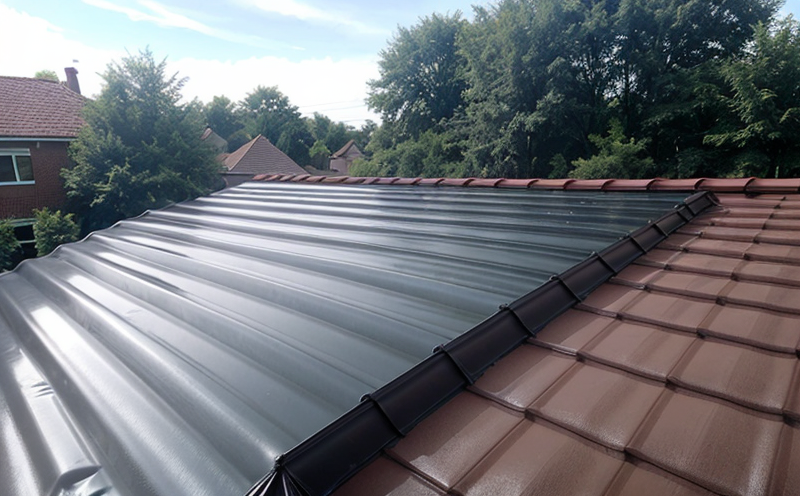EN 12317-2 Elongation Properties Measurement
The measurement of elongation properties according to EN 12317-2 is a critical procedure for ensuring the quality and performance of roofing and waterproofing materials. This standard provides precise methods for determining how much a material can be stretched before it begins to tear or break, which is crucial in assessing its durability under stress.
The elongation properties are essential for predicting the lifespan of roofing membranes, sheets, and coatings. Understanding these properties helps in selecting materials that can withstand environmental conditions such as temperature fluctuations, UV exposure, and mechanical loads without compromising performance. This service ensures compliance with industry standards and supports product development by providing accurate data on material behavior.
The process involves specimen preparation where small pieces of the roofing or waterproofing material are cut to specific dimensions according to EN 12317-2. These specimens are then placed in a tensile tester, which applies controlled forces until elongation begins and continues until failure. The equipment used includes high-precision tensile testing machines capable of measuring elongation with millimetre precision.
The test results provide valuable insights into the material's stress-strain relationship, which is essential for quality assurance in construction projects. This information helps in optimizing product formulations to enhance performance and longevity. Compliance with EN 12317-2 ensures that materials meet stringent quality standards, thereby reducing the risk of failures in roofing and waterproofing systems.
Accurate measurement of elongation properties is vital for selecting the right material for specific applications. For instance, in cold climates, materials need to be more flexible to accommodate thermal expansion without cracking. In tropical regions, materials should have higher tensile strength to withstand high wind loads and temperature variations.
The service also supports R&D efforts by providing a benchmark against which new formulations can be tested. This allows for continuous improvement of roofing and waterproofing products, ensuring they meet or exceed current standards while being prepared for future regulations.
In conclusion, the measurement of elongation properties according to EN 12317-2 is not just a regulatory requirement but also an essential tool in quality control and product development. It ensures that materials perform as expected under real-world conditions, contributing to the overall success of construction projects.
Applied Standards
| Standard | Description |
|---|---|
| EN 12317-2 | European standard for the determination of elongation properties in roofing and waterproofing materials. |
| ASTM D665 | American Society for Testing Materials method for determining tensile properties of plastics. |
| Standard | Description |
|---|---|
| ISO 178 | International Organization for Standardization standard for the determination of tensile properties of plastics. |
| EN ISO 527-4 | European standard for the determination of tensile properties in plastics. |
Environmental and Sustainability Contributions
The measurement of elongation properties as per EN 12317-2 plays a significant role in environmental sustainability by ensuring that roofing and waterproofing materials are robust enough to last longer, reducing the need for frequent replacements. This extends the lifecycle of buildings, which is beneficial from both an economic and ecological perspective.
By selecting materials with excellent elongation properties, construction projects can minimize waste generation during maintenance and repair phases. Longer-lasting materials also reduce energy consumption associated with heating or cooling, as they provide better insulation against temperature fluctuations. This contributes to lower carbon footprints in the built environment.
The service supports sustainable building practices by providing accurate data that helps architects and engineers make informed decisions about material selection. This ensures that new constructions are designed with longevity in mind, thereby promoting a circular economy within the construction industry.
Moreover, compliance with EN 12317-2 standards is increasingly becoming a requirement for green building certifications such as LEED (Leadership in Energy and Environmental Design) and BREEAM (Building Research Establishment Environmental Assessment Method). This enhances a project's environmental credentials and can lead to cost savings through reduced energy consumption and lower maintenance costs.
Competitive Advantage and Market Impact
- Ensures compliance with international standards, increasing market access.
- Provides robust data for product development and optimization.
- Supports sustainable building practices, enhancing a project's environmental credentials.
- Promotes longevity of roofing and waterproofing systems, reducing maintenance costs.
The ability to measure elongation properties accurately gives businesses a competitive edge by ensuring high-quality products that meet the most stringent international standards. This not only enhances brand reputation but also supports long-term relationships with satisfied customers who trust in the durability and reliability of these materials.
By demonstrating compliance with EN 12317-2, companies can differentiate themselves from competitors, especially in markets where environmental considerations are becoming more important. The service helps businesses stay ahead of regulatory changes and industry trends, ensuring they remain relevant and competitive in a rapidly evolving market.





